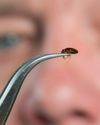
Whether disrupting air traffic, returning glorious vistas of Earth from above, or just spying on the neighbours (if that’s your thing), drones have become a familiar sight in our skies. Now, for the first time, the US space agency NASA is poised to fly a drone-like helicopter in the atmosphere of another planet.
The craft, named Ingenuity, will hitch a ride to the Red Planet aboard the one-tonne Perseverance lander, NASA’s latest wheeled robotic rover mission to drive across the planet’s rugged surface. Perseverance will launch from Earth soon, with a touch down on Mars scheduled for 18 February 2021.
Flying in the alien atmosphere of another world is a feat that poses a unique set of engineering challenges and yet, if this small technology test mission is successful, it will furnish scientists with a new and highly effective way to explore the planets and moons of our solar system. That’s because flying is a much faster way to get around than ground roving. Aircraft can gather aerial imagery that’s much sharper than pictures returned by spacecraft. They can also serve as scouts to identify potential targets for ground-based rover vehicles, and they can even gather samples and bring them back to a central lander station for analysis. And, of course, they can go where other probes simply can’t.
This story is from the September/October 2020 edition of Very Interesting.
Start your 7-day Magzter GOLD free trial to access thousands of curated premium stories, and 9,000+ magazines and newspapers.
Already a subscriber ? Sign In
This story is from the September/October 2020 edition of Very Interesting.
Start your 7-day Magzter GOLD free trial to access thousands of curated premium stories, and 9,000+ magazines and newspapers.
Already a subscriber? Sign In

TAKE IT SLOW
Slow running is a fitness trend with some hard and fast science behind it

Physics, AI and music share a common thread. You just have to know where to look
Studying science can lead you in many directions and open doors to unexpected possibilities along the way

BED BUGS VS THE WORLD
When bloodthirsty bed bugs made headlines for infesting Paris Fashion Week in 2023, it shone a spotlight on a problem that's been making experts itch for decades: the arms race going on between bed bugs and humans

Kids are the key to understanding obesity. But we need more of their genes...
We can unravel the role that bodyweight plays in disease, but we need a bigger, more diverse, sample of genetic material to do so

COVID inquiry: What did we learn and what can we do better in future pandemics?
Masks, social distancing, lockdowns... how effective was the UK's response to the COVID-19 pandemic?

One hormone could be the key that unlocks a cure for morning sickness
The nausea and vomiting that, in extreme cases, can endanger mothers and babies might soon be just a memory

THE WORLD'S WEIRDEST CREATURES
Under the sea and upon the land, some animals look - to us - pretty strange...

WHEN MIND AND MACHINE COLLIDE
First, Elon Musk wanted to make electric cars ubiquitous, then he wanted to make space exploration a private enterprise. Now, with Neuralink, his newest venture, Musk hopes to merge humans and artificial intelligence. Turns out, it might not be such a crazy idea...

COME OUT OF YOUR SHELL
Social anxiety is more than just being shy. It's a phobia born out of our evolutionary past. But that raises a puzzling question: why do so many of us fear human interaction when we're supposed to be the most sociable species on the planet?

SPACE ODDITIES
Take a tour of the weirdest spots in the universe, where the 'normal' rules don't apply. Places that squeeze time, blow bubbles and even rain glass... sideways